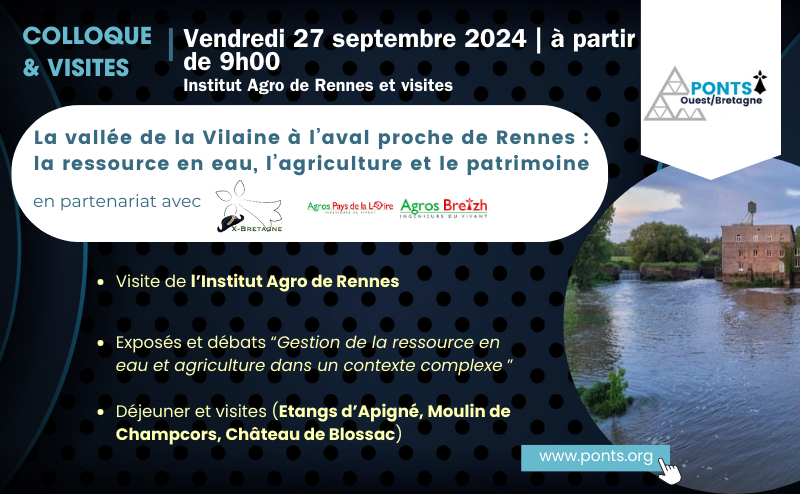Water symposium and visits to the Rennes basin
September 27, 2024, Rennes et Vilaine
The Vilaine valley downstream near Rennes:
water resources, agriculture and heritage
Several tours of the Vilaine valley have already been organized by regional groups from X-Bretagne, Agrobreizh, Agros des pays de Loire, Ponts alumni Ouest/Bretagne: from the Atlantic Ocean to Pont-Réan.
The event, to be held on September 27, will focus on the last sector from the Vilaine to Rennes.
The program includes :
- From 9:00 to 10:30 a.m.: visit to the Institut Agro de Rennes (65, route de Saint Brieuc) led by its Director Alessia Lefébure
- From 10:45 am to 12:45 pm: presentations and debates on the management of water resources and agriculture in the context of climate change.
Eric Fisse, Regional Director for the Environment, Planning and Housing in Brittany, will present public policies designed to preserve water resources, aquatic environments and their uses.
Zahra Thomas, Professor at the Institut Agro Rennes Angers (UMR SAS), will illustrate the role of scientists in helping to make decisions about water resource management in a complex context.
Laurent Géneau, Director of the "Eau du Bassin Rennais" local authority, will present the developments underway to ensure a safe drinking water supply for the city of Rennes and the surrounding area.
- 1:00 pm to 3:00 pm: refreshments and lunch at the Etangs d'Apigné site, presentation of the Etang des Bougrières used to supply drinking water.
- 3:15 to 4:30 p.m.: Tour of the Champcors mill
- From 4.45pm to 6pm: tour of the Château de Blossac
The Champcors mill:
It is the only survivor of a group of 6 mills built around 1014 on the initiative of Alain III, Duke of Brittany, as a gift to the Saint Georges abbey he founded a few years earlier.
The Pivan family has owned the mill since 1953. It is involved in the "Terres de Sources" initiative launched by Eau du Bassin Rennais.
The river's energy, once used to turn stone millstones, is now used to generate the electricity that powers the various mills. The current equipment, mainly made of stainless steel, was installed in March 2023.
Château de Blossac:
Situated at the confluence of the Meu and Vilaine rivers, this château was built by the de La Bourdonnaye family, from whom the current owners, Alexia and Christophe de la Rousserie, are descended.
The central part, with its flow-through rooms, was built in 1672. Two wings, one of which contains a chapel of great heritage interest, were added at the end of the 18th century. The ensemble, a monument of great architectural quality, is currently being restored.
Online registration required below. Participation fee of 12 Euros.
Information from Francis.



